In case you haven’t heard, 802.11ac Wave 2 is here. We’ve been shipping our first 802.11ac Wave 2 access points, the Aironet 1850 and 1830 since the the middle of 2015 and the list of 802.11ac Wave 2 client devices is growing almost daily. The most important enhancement to 802.11ac Wave 2 is multi-user MIMO (MU-MIMO). MU-MIMO gives access points the ability to transmit to multiple clients at the same time, instead of one after a nother. For a more in-depth look at MU-MIMO, check out our 802.11ac White Paper.
nother. For a more in-depth look at MU-MIMO, check out our 802.11ac White Paper.
At Cisco we pride ourselves on high-performing hardware, as well as an unparalleled software feature set. So to back this up, we asked Miercom, a leading independent testing company, to help us verify the performance of our 802.11ac Wave 2 access points against the competition. For Cisco, the contenders were:
- Cisco Aironet 1852i, a 4×4:4 AP, supports MU-MIMO, and has two gigabit Ethernet uplinks, and a USB port.
- Cisco Aironet 1832i, a 3×3:2 AP, with MU-MIMO support and a USB port.
- Cisco Aironet 3702i, a 4×4:3 AP with Cisco High Density Experience (HDX) and a slot for an expansion module.
- The results from Miercom are clear:
• The Aironet 1852i is the lowest cost, highest performing 4×4:4 802.11ac Wave 2 access point on the market.
• The Aironet 3702i is the undisputed leader of challenging highly dense environments, even amongst newer wave 2 access points.
• The 3×3:2 Aironet 1832 exceeds or keeps pace with the more expensive 4×4:4 competition.
The full report can be found here. The rest of this blog will walk through the report and summarize the test cases and results.
Report Overview
The report focuses on comparing the Cisco Aironet 1852 against the Aruba AP-325 and Ruckus
R710, when relevant test cases also include the Cisco Aironet 3702 and 1832.
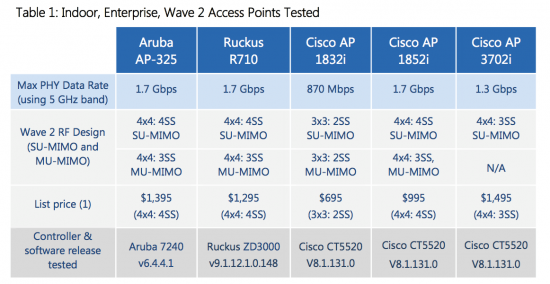
The three test cases in the report focus on demonstrating the performance of the APs:
• Test Case 1: Multi-Client Performance
• Test Case 2: MU-MIMO
• Test Case 3: Link Aggregation (LAG) for 1Gbps of wireless throughput
Test Case 1: Multi-Client Performance
For the Multi-Client Performance test, the test bed used 100 real clients to stress the performance of the access points as the scale increased—in 10 client increments—from 10 to 100 clients. There was a mix of 802.11n and 802.11ac clients connected to both 5 GHz and 2.4 GHz coupled with a 70%/30% spread of clients maintained between 5 GHz and 2.4GHz.
The Aironet 3702i came out on top in this test, even against the newer 802.11ac Wave 2 access points. The Aironet 3702i is built to handle the most demanding of RF environments, thanks to Cisco High Density Experience (HDX). Not only did the Aironet 3702i maintain the highest throughput (first graph below), but probably most importantly, it did so while fairly serving every single client (second graph below). In second place was the Aironet 1852i with a respectable showings in both the throughput and client fairness portions. The Aironet 1832i had comparable throughput to the Ruckus R710, but when you look at the fairness graph, it’s a completely different story. The R710 averaged more than a 10% failure rate for all the tests. The Aruba AP-325 finished at the bottom of the standing with a poor throughput and a sub-optimal failed client percentage in the higher client counts.
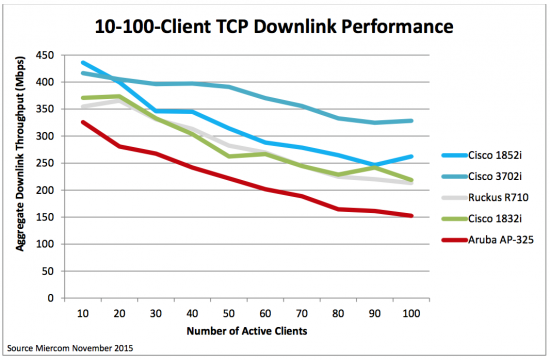
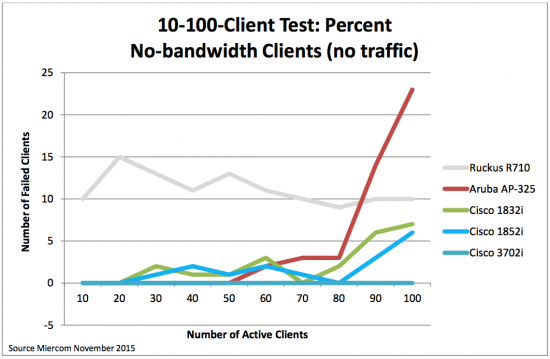
Test Case 2: MU-MIMO
MU-MIMO is the big attraction in 802.11ac Wave 2. It’s not going to make your Wi-Fi network switch-like, but it likely will allow for modest gains in performance. MU-MIMO doesn’t increase the maximum throughput, rather it makes better use of an access point’s transmitters. An access point typically has more transmitters than a client has receivers. MU-MIMO allows for those extra transmitters to transmit to other clients at the same time. That is, a 4×4 access point in 802.11ac Wave 1 days—also known as single-user (SU) MIMO—could only transmit to a single one-spatial stream client at a time, leaving three transmitters unused. With 802.11ac Wave 2 and MU-MIMO, a 4×4 AP can transmit to three one-spatial stream clients simultaneously, making better use of the access point. It should be noted, that both the access point and the client need to support MU-MIMO.
The MU-MIMO test case Miercom devised was comprised of two scenarios. The first scenario compared SU- MIMO to MU-MIMO by testing 10 SU-MIMO clients. From there the lab removed one SU client, and replaced it with an MU-MIMO client and repeated that until there were 10 MU clients. The second scenario tested MU-MIMO performance with 10, 20, and 30 clients.
MU-MIMO is not an easy task to accomplish, especially in a constantly changing RF environment. The access point had up the three separate transmissions destined for three different clients. The access point had to transmit to those clients in such a way that each client only received the transmission meant for itself.
The Aironet 1852i did a great job with this tests’ transmissions, yielding a 1.7x to 1.9x gain with MU-MIMO. The Ruckus R710 had modest gains for 10 clients, and no gain for 20 and 30 clients. The Aruba AP-325 actually showed a decrease with MU-MIMO enabled for all the tests.
Scenario 1: 1-for-1 MU-MIMO
This test is interesting because it clearly shows the benefit MU-MIMO possesses. In 802.11ac one of the ways to easily increase throughput is to double the channel width- from 20 MHz, to 40 MHz, to 80 MHz. This is not a scalable solution because you’ll reach a point, especially with 80 wide channels, where you’re reusing the same channels and no longer increasing your capacity. MU-MIMO allows you the increase your capacity, without increasing channel width. These tests purposefully use 20 MHz wide channels to show how aggregate throughput increases (purple line) as the number of MU clients increases.
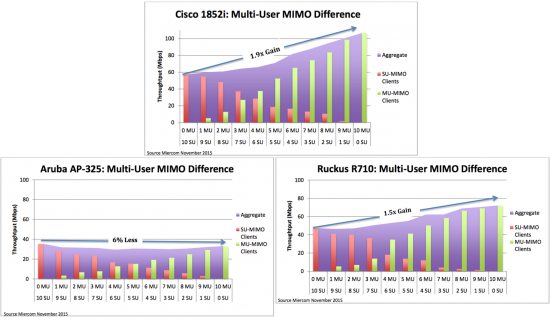
Scenario 2: Multi-Client MU-MIMO
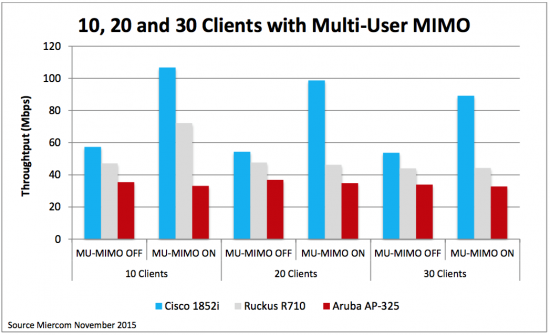
Test Case 3: Link Aggregation (LAG) for +1 Gbps of wireless throughput
These 802.11ac Wave 2 access points are capable of impressive data rates, which far exceed 1 Gbps. Just a reminder: data rate does not equal real throughput. The final test case hoped to see if these access points could meet or exceed the 1 Gbps throughput mark. Both gigabit Ethernet ports on the access points were used in link aggregation (LAG) mode. A four spatial stream client was connected on 5GHz, and a three spatial stream client connected on 2.4GHz. The scenario was unlikely to be a common customer scenario, but we were curious to see how the access points could perform. The Aironet 1852i was the only access point to exceed 1Gbps, while Ruckus and Aruba were well under the 1 Gbps mark.
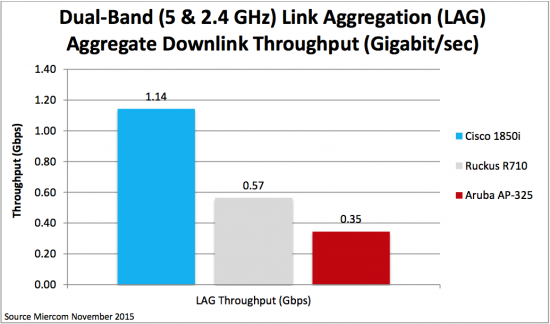
Summary
Cisco recognizes the inevitability of 802.11ac Wave 2 adoption in the future. Coupled with the value of MU-MIMO, the Cisco Aironet 1830 Series and 1850 Series access points are perfect devices when updating your wireless network. With terrific performance that blows the industry rivals away that are also priced several hundred dollars cheaper than the competition, these access points are an obvious solution to your wireless network needs.
Check out the report for full details on the tests, results, and methodology of how the tests were carried out.


A matter of opinon.. Go to Ruckus or Aruba to the the opposite. These results are never truthfull and not even of concern in design.